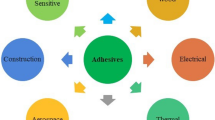Abstract
The aim of this study was to evaluate through differential thermal analysis and thermogravimetry (TG–DTA) the thermal behavior of a bulk-fill composite, as a function of the curing depth; the objective was to verify whether it could be cured in greater increments with respect to the traditional dental composites. Samples of Tetric EvoCeram Bulk Fill (Ivoclar Vivadent) photopolymerized for 20 s at different curing depths (1–10 mm) have been analyzed, five samples of each layer, through the TG–DTA. The thermogravimetric curve (TG), the differential thermal analysis (DTA), and the first derivative of loss of mass (DTG) have been analyzed. The average temperature at which 5 % of mass loss occurred and the percentage of the average mass loss between 250 and 350 °C have been recorded. Analysis of variance and Bonferroni/Dunn test have shown statistically significant differences for what concerning all parameters analyzed in the first four layers versus the others. There were no significant differences in the thermal behavior of samples comprised between 1 and 4 mm. On the contrary, samples higher to 6 mm seemed to be not enough polymerized; 5-mm layers presented and intermediate polymerization. The TG–DTA has shown that this material shows the same thermal behavior in the first 4 mm if photopolymerized and for this reason it could be used in increment until 4 mm thickness.



Similar content being viewed by others
References
Pamela S, Stein JS, Haubenreicb JE, Osborne PB. Composite resin in medicine and dentistry. J Long Term Eff Med Implants. 2005;15:641–54.
Petrini M, Ferrante M, Su B. Fabrication and characterization of biomimetic ceramic/polymer composite materials for dental restoration. Dent Mater. 2013;29(4):375–81.
Stansbury JW. Curing dental resins and composites by photopolymerization. J Esthet Dent. 2000;12:300–8.
Ruyter IE, Oeysaed H. Composites for use in posterior teeth: composition and conversion. Biomed Mater Res. 1987;21:11.
Price RB, Murphy DG, Dérand T. Light energy transmission through cured resin composite and human dentin. Quintessence Int. 2000;31:659–67.
Flury S, Hayoz S, Peutzfeldt A, Hüsler J, Lussi A. Depth of cure of resin composites: Is the ISO 4049 method suitable for bulk fill materials? Dent Mater. 2012;28(5):521–8.
Ferracane JL. Resin composite-state of the art. Dent Mater. 2011;27(1):29–38. doi:10.1016/j.dental.2010.10.020.
Ferrante M, Dottore P, Petrini M, Trentini P, Spoto G. Evaluation of different light-curing lamps: halogen versus new-diode lamp. J Therm Anal Calorim. 2012;109(2):939–44.
Sampath S, Girish SR. Thermal studies on different classes of clinical dental composites. J Therm Anal Calorim. 2013;111(1):219–25.
Ferrante M, Petrini M, Trentini P, Ciavarelli L, Spoto G. Thermal analysis of light-curing composites. J Therm Anal Calorim. 2010;102(1):107–11.
Ferrante M, Petrini M, Trentini P, Spoto G. Evaluation of composites light-curing at different times and distances of irradiation. J Therm Anal Calorim. 2012;107(2):757–61. doi:10.1007/s10973-011-1516-7.
Ilie N, Keßler A, Durner J. Influence of various irradiation processes on the mechanical properties and polymerisation kinetics of bulk-fill resin based composites. J Dent. 2013;41(8):695–702.
Moszner N, Fischer UK, Ganster B, Liska R, Rheinberger V. Benzoyl germanium derivatives as novel visible light photoinitiators for dental materials. Dent Mater. 2008;24:901–7.
Li X, Pongprueksa P, Van Meerbeek B, De Munck J. Curing profile of bulk-fill resin-based composites. J Dent. 2015. doi:10.1016/j.jdent.2015.01.002.
Liu D, Hou, Z-G. In: Advances in neural networks—ISNN 2007: 4th International Symposium on Neutral Networks, ISNN 2007 Nanjing, China, June 3–7, 2007. Proceedings.
Gabbot P. Principles and applications of thermal analysis. Hoboken: Blackwell Publishing Ltd; 2008.
Halvorson RH, Erickson RL, Davidson CL. The effect of filler and silane content on conversion of resin-based composite. Dent Mater. 2003;19(4):327–33.
Liu Q, Ding J, Chambers DE, Debnath S, Wunder SL, Baran GR. Filler-coupling agent-matrix interactions in silica/polymethylmethacrylate composites. J Biomed Mater Res. 2001;57(3):384–93.
Acknowledgements
Authors would like to express sincere thanks to Dr. Domenico Vitale, Dr. Paolo Trentini, and Dr. Lorenzo Barassi for the technical support.
Author information
Authors and Affiliations
Corresponding author
Rights and permissions
About this article
Cite this article
Petrini, M., Ferrante, M. & Spoto, G. Characterization of a bulk-fill resin-based composite by thermal analysis. J Therm Anal Calorim 123, 2329–2335 (2016). https://doi.org/10.1007/s10973-015-5037-7
Received:
Accepted:
Published:
Issue Date:
DOI: https://doi.org/10.1007/s10973-015-5037-7




